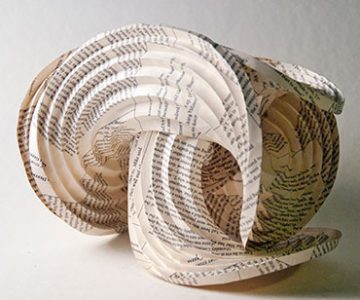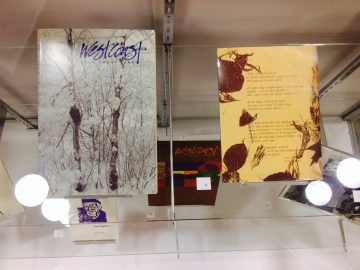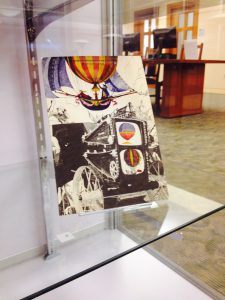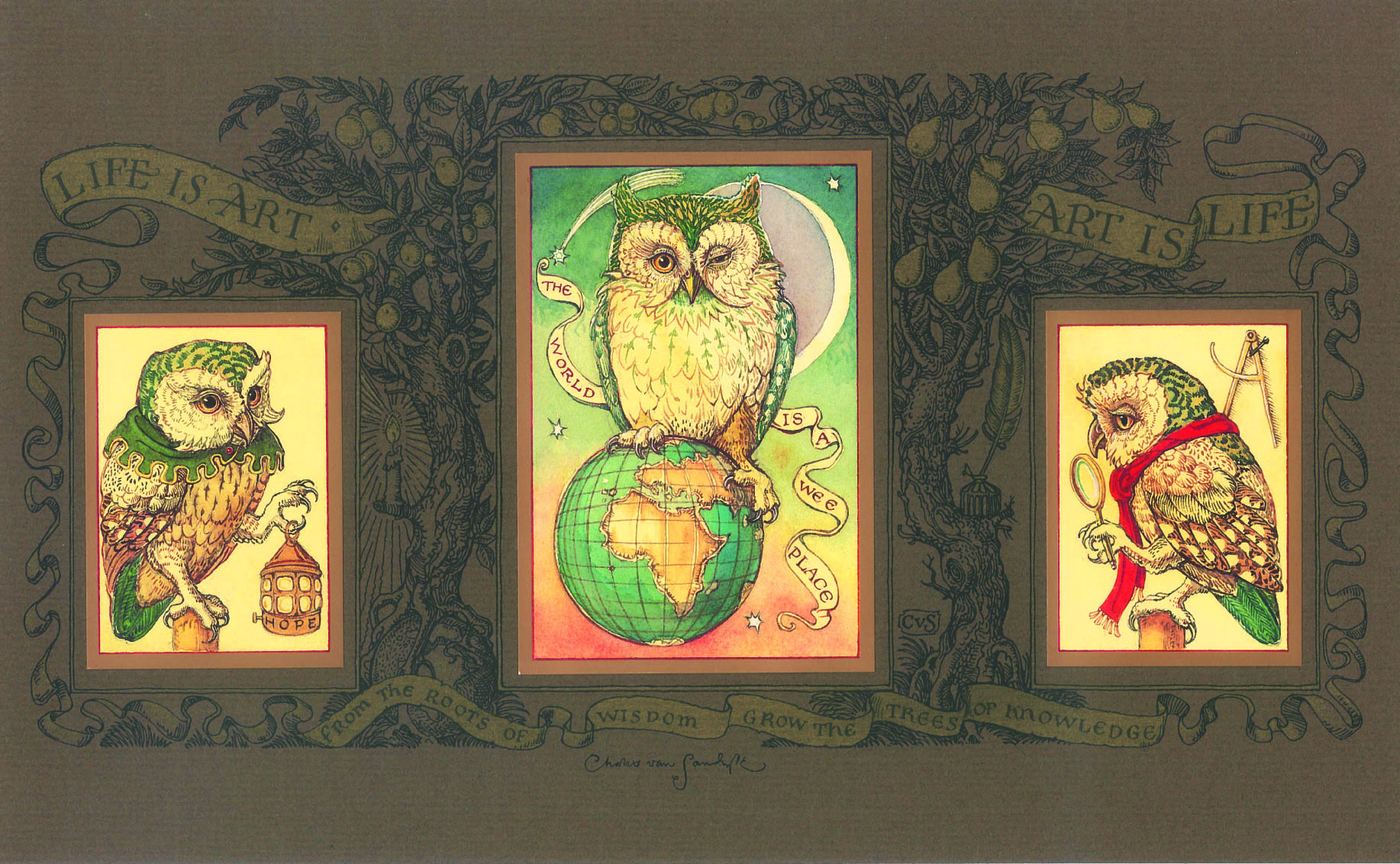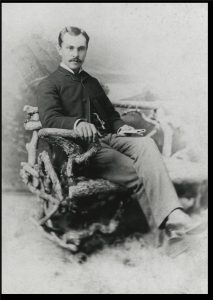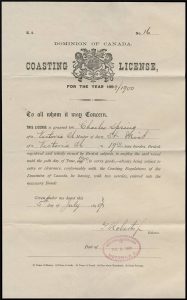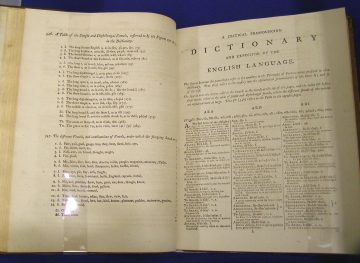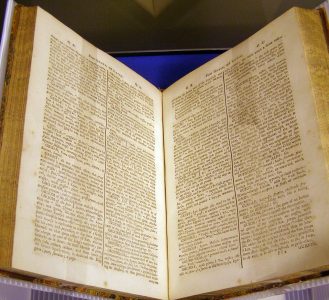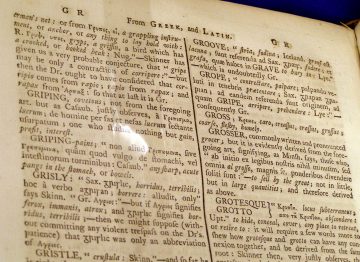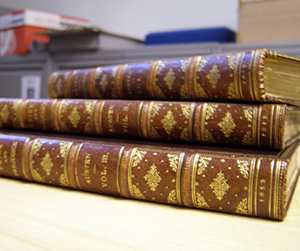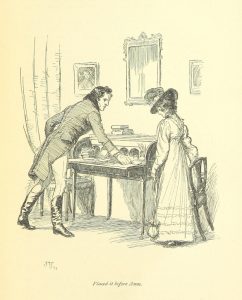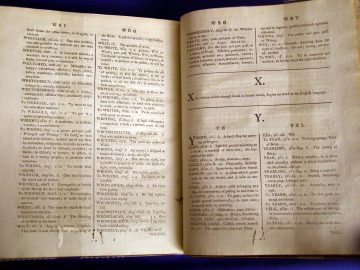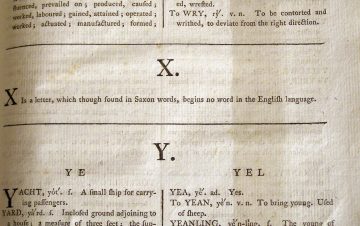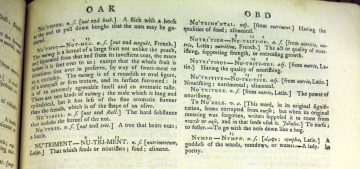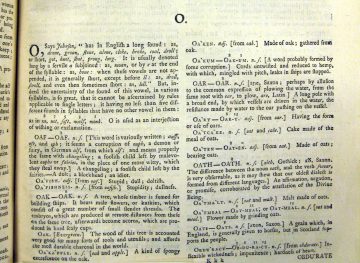Art of the Book open house!
Posted on February 28, 2017 @2:47 pm by cshriver
This Thursday, May 8, at 5:30 p.m., please join RBSC for an open house that offers a chance to view the delightful and surprising Art of the Book 2013 exhibition and to hear local book artists and members of Canadian Bookbinders and Book Artists Guild (CBBAG) discuss the works featured in the exhibition.
The open house will take place at UBC Library’s Rare Books and Special Collections, 1961 East Mall, in the Irving K. Barber Learning Centre, Level 1. Read more about the Art of the Book 2013 exhibition here!
No Comments
Posted in Announcements, Events, Exhibitions, Uncategorized | Tagged with
Exhibition of works by Roy K. Kiyooka
Posted on February 28, 2017 @2:47 pm by sromkey
Resistant to mainstream ideas of national identity, artistic success, and artistic conventions, Roy K. Kiyooka’s flexible, unconventional use of language in his poetry voices his Japanese-Canadian ‘inglish’ and questions his Canadian identity in light of the internment faced by Japanese-Canadian citizens during World War II. Kiyooka’s poetry has been anthologized in Canadian poetry collections and in the posthumously published Pacific Windows, edited by Roy Miki. In 1987, his Pear Tree Pomes was short listed for the Governor General’s Literary Award. However, despite his national recognition, Kiyooka remains relatively unknown outside academic and literary communities. In recognition of the twentieth anniversary of his passing, the students of ASTU 400M are showcasing original print chapbooks of Kiyooka’s work and archival material to commemorate his enduring influence and unforgettable contribution to Vancouver’s (and Canada’s) artistic scene.
Hosted at Rare Books & Special on floor 1 of Irving K. Barber Learning Commons, the exhibition runs March 17-31, 2014 and is accessible 10am-4pm Monday through Friday and 12pm-5pm Saturdays.
No Comments
Posted in Exhibitions, Uncategorized | Tagged with
New in the Archives : 28 Years of Charles van Sandwyk’s work
Posted on February 28, 2017 @2:48 pm by kferrante
We recently had the pleasure of adding a new group of unique and beautiful items to our collection of Charles van Sandwyk material. For those of you not familiar with his delightful body of work, Charles is a local artist, illustrator and author whose published books we have been collecting for many years. Each of these books is quite a treat. They are all designed, written and illustrated by Charles, who also oversees every step of their publication.
Charles’ books are difficult to categorize – on first glance they appear to be meant for children, yet there is something about the imaginative world that Charles creates within them that equally, if not even more so, captures the attention of adults.
This latest accrual adds an exciting new layer to our Charles van Sandwyk collection by offering a glimpse behind the scenes of Charles’ work and showing his development as an artist since the age of 18. It contains over 50 items – many one-of-a-kind – including printing proofs for his books, posters for exhibits of his work, original artwork, book prospectuses, broadsides, photographs, and banners he created for the village of Deep Cove, where he resides for much of the year. This collection will be valuable to anyone interested in learning more about Charles’ work, about the Vancouver book publishing and art world, or about independent fine art and letterpress printing.
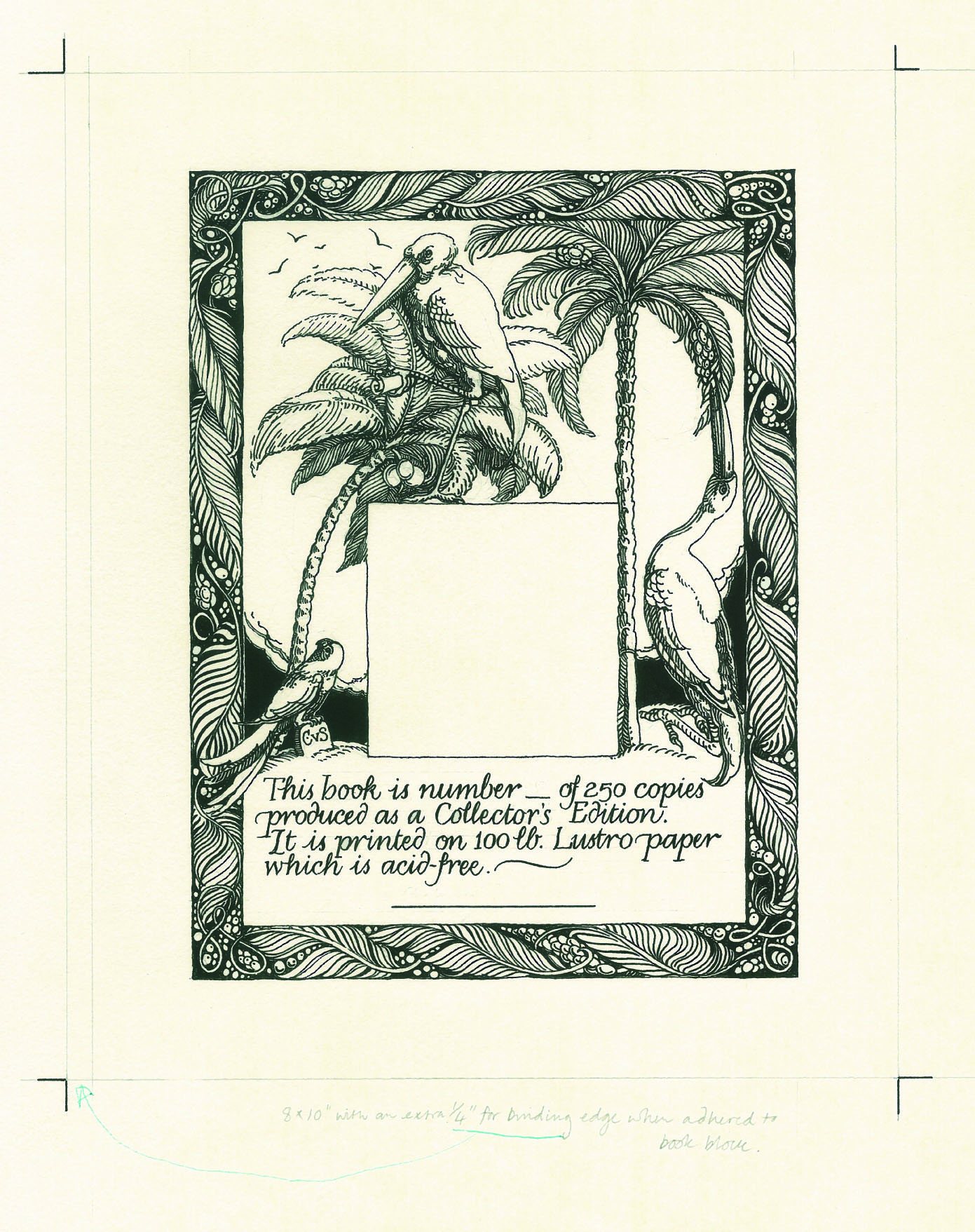
Parade to Paradise, original artwork, 1992. Signed and annotated by Charles, with notes about printing.
A full description of the items is available here.
The items were brought together by the Joyce Williams Gallery, with the assistance of Charles, in the hopes of creating a body of work that would illustrate Charles’ progression over the years. It begins with material from his first exhibit in 1984 – including a drawing, a postcard invitation, and photographs of the young Charles – and progresses through 2012, with press proofs from his book I Believe: Two Poems & a Hidden Thought and a delightful hand drawn map of the small Fijian Island of Tavewa, where Charles spends his winters.
We are excited to be preserving this important piece of our local art and publishing history and hope that you will have a chance to come in and enjoy it for yourself!
No Comments
Posted in Announcements, Collections, Newest-Collection, Uncategorized | Tagged with Art, Charles Van Sandwyk, Children's Literature
Scanned, sealed (pun intended), and delivered
Posted on February 28, 2017 @2:49 pm by cshriver
Last summer, we processed a very interesting new fonds here at RBSC. The Charles E. Spring (1859-1938) fonds provides great insight into the sealing industry of British Columbia in the late 19th and early 20th centuries, as well as the on-going campaign of one man to receive restitution for the loss of his business. The son of a pioneering sealer and trader in British Columbia, Spring was educated in Victoria and worked for the Hudson’s Bay Company before taking over the family sealing business at the age of 24 upon the death of his father. Spring’s business suffered when, in 1885, United States cutters began seizing vessels caught sealing in the North Pacific in order to protect their sealing interests in Alaska. Later, in order to ease tensions between the United States and Great Britain over the Bering Sea controversy, a temporary agreement (the “Modus Vivendi”) prohibiting pelagic sealing in the Bering Sea was put in place for the 1891-1892 and 1892-1893 seasons. The resulting loss of revenue financially ruined Spring. Although Spring received a settlement for financial losses caused by the seizure of one of his ships and the “Modus Vivendi” during the 1891-1892 season, he continued to pursue claims for losses suffered due to the extension of the “Modus Vivendi” during the 1892-1893 season. He also became an active spokesman for other sealers in their claims.
The Charles E. Spring fonds contains records spanning the period 1888-1937 relating to the sealing industry and Spring’s claims for financial losses. A number of items from the Charles E. Spring fonds have been digitized and are now available through the Adam Matthew research database “China, America and the Pacific: Trade and Cultural Exchange”. The database is available to UBC students and faculty with a campus-wide login, or to the larger community by visiting a UBC Library and logging on to a UBC networked computer. Database users will be able to view high-resolution scans of a number of items from the Charles E. Spring fonds, including the ledgers of several schooners, crew agreements, petitions, memoranda and memorials, correspondence, court papers, log books, photographs, and more. We’re so happy to be able to share these materials and this fascinating look into B.C.’s sealing industry with all of you.
No CommentsPosted in Announcements, Collections, Newest-Collection, Research and learning, Services, Uncategorized | Tagged with
Featured place: Wells, B.C.
Posted on February 28, 2017 @2:49 pm by sromkey
Friends and colleagues, we have a New Year’s resolution for 2014: to finally finish all of our Featured Place posts for our blog! This has been an ongoing feature where we feature items in our collections relating to the places in B.C. that are the namesakes of the rooms in the Irving K. Barber Learning Centre.
Today we’re going to look for resources to do with Wells B.C. Wells is located in the Cariboo district between Quesnel and Barkerville- much closer to Barkerville though! Today it is mostly a tourist town, accommodating visitors on their way to Barkerville, but it was originally founded as a company town for the Cariboo Gold Quartz Mining Company- whose archives we happen to house here in Rare Books and Special Collection. The town of Wells was named after one of the founders of the company, Fred Wells. The town was established in the first year the mine went into production, which was 1933, and the population plummeted when the mine closed in 1967.
In addition to letters, reports, and maps, the fonds has a number of photographs showing the development of the mine and the town. These mini panoramas (the originals are just over 15 cm in length!) show the mine and the surrounding area ca. the 1930’s:
You can click on the images above to see them much larger. The Wells Classroom is room 461 in the Barber Centre.
We’re looking forward to featuring more B.C. places in 2014- we hope you’ll read along with us!
No Comments
Posted in Collections, Uncategorized | Tagged with Barber
The final installment!
Posted on February 28, 2017 @2:51 pm by cshriver
Happy holidays from everyone here at Rare Books and Special Collections! As an early Christmas gift, we offer the final student dictionary report from the course English 320: History of the English Language. As I mentioned in last week’s post, the exhibition, The Road to the OED, has been extended until the end of January, so please feel free to stop by to see it when we open on January 2 after the winter break. Hope to see you then!
Walker, John. A Critical Pronouncing Dictionary and Expositor of the English Language. London: G. G. J. and J. Robinson, 1791. PE25 .R62 V. 315
Written by elocutionist / lexicographer John Walker and released in 1791, A Critical Pronouncing Dictionary and Expositor became renowned as the ‘statute book of English ortheopy’ that ‘settled all doubts’ on issues of English pronunciation (Beal). Born in 1732, Walker was an actor who performed in Bristol, Dublin and London with various acting companies. He married a fellow actress, Sybilla Minors, and after his marriage he converted to Catholicism. After 1768 he retired from acting and became a successful teacher of elocution. He became a popular lecturer frequently invited to give private lectures at various Universities including Oxford and Dublin. He wrote many books on elocution but it is his dictionary for which he is most famous. Walker continued to publish books on the English language until his death in 1807.
What makes his dictionary unique is that it features a section tailored for different speakers on proper pronunciation. There are articles dedicated to rules that Irish and Scottish people should observe for correct pronunciation of English, an article for foreigners in learning English, and an article pointing out the faults of pronunciation of London speakers. There is also a section entitled “Principle of English Language,” containing over 558 rules on proper English pronunciation. In the dictionary proper, some words contain numbered parenthesis which refer to different rules of the “Principles.” Each word in the dictionary contains a definition, a pronunciation guide and sometimes a note which addresses controversies on the pronunciation of the word. Unlike modern dictionaries which employ the IPA system of writing pronunciation, this dictionary follows Thomas Sheridan’s 1780 dictionary system. This system syllabifies words and indicates variations of vowel pronunciation with a superscripted number.
To situate this work within the history of English lexicography, Walker’s preface gives credit to predecessor dictionaries of Johnson (1747), Kenrick (1773), and Sheridan (1780) among others. According to Walker, each dictionary is “greatly superior to every other that preceded it” (Walker, iii). However, he is critical of the all the various inconsistencies in these dictionaries. Therefore the purpose of Walker’s dictionary was to provide an authoritative and elaborative work that addresses these inconsistencies. On the spectrum of linguistic prescriptivism and descriptivism, Walker is unabashedly prescriptive. He points out that Sheridan is Irish, and that his dictionary pronunciations lean towards an Irish accent which is incorrect in Walker’s view. His “Principles of the English Language” and various guides for “Just Pronunciation” effectively demonstrate his inclinations towards linguistic prescriptivism.
— Anthony Bigornia (English 320: History of the English Language, 2012-2013)
No CommentsPosted in Announcements, Exhibitions, Uncategorized | Tagged with
The etymology of Lemon…George Lemon
Posted on February 28, 2017 @2:50 pm by cshriver
With the holidays just around the corner, I know you are all worried about making time (in between shopping, baking, wrapping, packing, cleaning, etc.) to visit The Road to the OED exhibition at Rare Books and Special Collections before it closes on December 24. Well, worry no longer! The exhibition has been extended until the end of January, so we look forward to seeing you all in the New Year!
In this week’s student dictionary report from the course English 320: History of the English Language, we learn about etymologist George Lemon and his study of the roots of the English language.
Lemon, George William. English Etymology; or, A Derivative Dictionary of the English Language. London: Printed for G. Robinson, 1783. PE25 .R62 V. 215
Born in Middlesex in 1726, George William Lemon led a life of various interests; he graduated from Queen’s College Cambridge with a BA, became an ordained priest in East Walton, and was high master at Norwich grammar school, until he resigned after controversy over his management of the school. His scholarly publications included a new Greek grammar to be put into use at the Norwich school, as well as a history of the War of the Roses. English Etymology; or a Derivative Dictionary of the English Language: in Two Alphabets was Lemon’s main lexicographical work, a 12,000 entry-long endeavour to chronicle the etymological roots of words in the English language, printed in 1783.
Whereas most modern dictionaries include a succinct account of each entry’s etymological background, Lemon’s etymological dictionary is formatted with a wider organizational scheme in mind. His dictionary is in two major parts, the first and larger section an alphabetized dictionary of words he determines as having Greek or Latin roots. The second, much smaller section, is a list of those words he considers as having been derived from Saxon and other “Northern dialects”. This division by etymological background functions to demonstrate what Lemon thought was “the whole force and power of the English language [to] know how much the greater part of it has been constructed on the Southern than on the Northern tongues”; that is, his belief that the English language’s apparent familial connections to the languages of antiquity, especially Classical Greek and Latin, was an expression of the language’s refinement and status as an internationally superior language.
As a dictionary whose focus is mainly on the etymological aspects of words, English Etymology does not include several of the features of modern monolingual dictionaries now considered standard; none of his entries include pronunciation or other basic information like part of speech, and most entries also do not provide a definition of the word beyond what can be understood from the forms he cites as etymological evidence. Also notable is his dependence on other etymologists, whose work Lemon compiled, edited, and disputed within many of the entries in his dictionary. “Who shall be able to account for the origin of language; or who shall say which was the original of all? Such an attempt would be a task too difficult for mortal man to accomplish”, says Lemon in his preface. His etymological dictionary, however, does attempt to draw connections between English and the languages of antiquity as it endeavours to support the English language as one worthy of extensive study and appreciation. As such, it certainly works within a tradition of lexicographical curiosity that continues to characterize the writing of dictionaries today.
— Kai Ying Chieh (English 320: History of the English Language, 2012-2013)
2 CommentsPosted in Announcements, Exhibitions, Uncategorized | Tagged with
Happy 238th birthday!
Posted on December 16, 2013 @10:09 am by cshriver
Today, December 16, is Jane Austen’s 238th birthday! I have quite a soft spot for our Jane, so I was too excited when a generous private donor gifted a first edition of Pride and Prejudice to Rare Books and Special Collections last year. We are also fortunate enough to have a first edition of Emma, Austen’s fourth novel and the last published before her death in 1817. In addition, we have some Victorian-era editions with lovely illustrations by Hugh Thomson and Charles E. Brock, as well as all kinds of other Jane Austen goodies.
Speaking of Hugh Thomson’s illustrations, the British Library has just released a number of scanned images on Flickr Commons for anyone to use, remix, and repurpose. Included in this amazing selection are Thomson’s illustrations of Austen’s novels, including this one of the famous scene in Persuasion when Captain Wentworth gives Anne Elliot “the letter.” If you don’t already know about “the letter,” you really should.
If you’d like to celebrate Jane’s birthday by coming down to Rare Books and Special Collections to see some of our Austen holdings in person, we’d love to see you in our reading room any time during our open hours! Remember that you do not need to be affiliated with UBC to use our resources.
So happy birthday, Jane! Thank you for sharing your considerable talent and for continuing to give the world so much pleasure through your enduring works.
No Comments
Posted in Announcements, Collections, Uncategorized | Tagged with
An actor turned lexicographer
Posted on February 28, 2017 @2:51 pm by cshriver
Now that classes at UBC are over, it’s a great time to stop by Rare Books and Special Collection to see our current exhibition The Road to the OED: A History of English-Language Dictionaries.
In this week’s student dictionary report from the course English 320: History of the English Language, we learn about Thomas Sheridan, an actor and playwright turned lexicographer who was also close friends with Jonathan Swift.
Sheridan, Thomas. A General Dictionary of the English Language. London : Printed for J. Dodsley … C. Dilly … and J. Wilkie, 1780. PE25 .R62 V. 288
Thomas Sheridan was an 18th-century actor, playwright, elocutionist, and educator who had a great deal of success in a number of fields. A tireless advocate for reform, Sheridan was able to raise the standard of the Dublin theatre scene, and make many strides in altering the contemporary opinion of a variety of issues related to elocution. Jonathan Swift, a close family friend, seems to have been an important inspiration for Sheridan’s interest in the written and spoken word. His 1780 dictionary, A General Dictionary of the English Language, one main object of which is to establish a plain and permanent standard of pronunciation, was a seminal development in the evolution toward a more comprehensive treatment of prescribed pronunciation.
Committed to a strong belief in the existence of proper universal pronunciation, Sheridan published one of the first serious attempts at bringing an informative and phonetically accurate representation of everyday words to the masses. In addition, he stirred debate in the academic community, inspired a number of critical reviews, and his dictionary eventually became an important source text for future pronunciation guides. Sheridan’s dictionary was popular in its day, leading to a release in at least 6 different editions in both Europe and North America.
In addition to the noteworthy phonetic guides present in each entry, Sheridan included a lengthy rhetorical grammar that serves as a pronunciation instruction manual, addresses contemporary pedagogy, and touches on regional and social varieties of language. Less a curatorial flaw than a curiosity and product of its time in the evolution of the language, Sheridan’s text did not include any words beginning with the letter x, instead noting that “X is a letter that, though found in Saxon words, begins no words in the English language”. Ultimately, Sheridan’s career in the theatre overshadowed his literary aspirations throughout his life, but the presence of phonetic pronunciations in contemporary dictionaries is a testament to the importance of his work as both an elocutionist and writer.
— Daniel Cooper (English 320: History of the English Language, 2012-2013)
No CommentsPosted in Exhibitions, Uncategorized | Tagged with
“One of London’s most despised, drunken, and morally degenerate hack writers…”
Posted on February 28, 2017 @2:51 pm by cshriver
For this week’s student dictionary report from the course English 320: History of the English Language…a tale of a particularly roguish lexicographer:
Kenrick, William. A New Dictionary of the English Language. London: Printed for J. and F. Rivington, W. Johnston, T. Longman, and T. Cadell, 1773. PE25 .R62 V. 206
Writer William Kenrick was born in 1725 in Hertfordshire, England. In his literary career, Kenrick began writing short pamphlets and articles for the monthly journal The Kapelion. He was also a self-proclaimed but unsuccessful satirist who enjoyed mocking other writers in his work. He took pleasure in his victims’ rebuttals and gladly wrote his own replies to himself when others ignored his insults. Though he delighted in attacking his peers in print and often wrote with animosity, Kenrick was a rather jovial character in person, though a pest to his colleagues. He has been described as “one of London’s most despised, drunken, and morally degenerate hack writers in the later eighteenth century” (Fussell).
Though his literary style was impressive, Kenrick could not attain the respected status of many of his peers. James Boswell noted that he “wrote with so little regard to decency and principles, and decorum, and in so hasty a manner, that his reputation was neither extensive nor lasting” (Boswell). Kenrick repeatedly condemned the work of Samuel Johnson, evoking an academic conflict between the two writers. Despite identifying the flaws of Johnson’s publications, Kenrick used much of Johnson’s work regarding pronunciation guides to include in his New Dictionary of the English Language in 1773. In many cases, the extractions were reproduced without changes. He also pursued editing and publishing endeavors and became the editor-in-chief for the London Review of English and Foreign Literature (Rogers and Rizzo). In his final years, Kenrick remarried twice and spent time in Fleet prison for debt. He died of unidentifiable causes in 1779.
As a final attempt to antagonize Samuel Johnson, Kenrick wrote A New Dictionary of the English Language, published in London in 1773. The new dictionary most notably introduced a new system of guiding pronunciation that includes numbers and accents to represent the pronunciation and stressed syllables of words. Thomas Sheridan developed but had not yet published this scheme, so Kenrick once again plagiarized to gain success and insult his peers. The dictionary also includes the section “Rhetorical Grammar,” which was published in London and Philadelphia in 1784. This section analyzes the various grammars and uses of the English language. The entries in this dictionary have similarities to modern English dictionaries, including etymological information and the aforementioned phonetic guide, though Kenrick occasionally includes biased witticisms to illustrate certain terms. Though some of the lexicon has changed in present day English based on context and modern technologies, this dictionary well represents a core vocabulary that applies to both the 18th century and the present.
— Jessica Shaw (English 320: History of the English Language, 2012-2013)
No Comments
Posted in Exhibitions, Uncategorized | Tagged with
